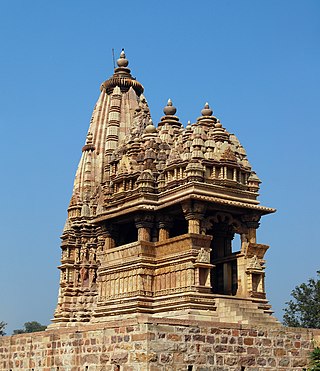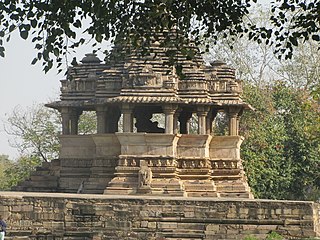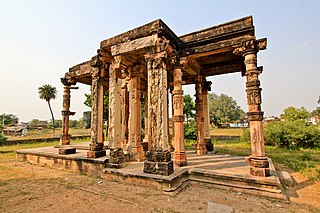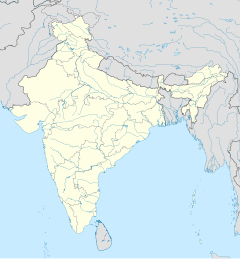
Devi Jagadambika Temple or Jagadambika Temple is one of a group of about 25 temples at Khajuraho, Madhya Pradesh, India. Along with the other temples at Khajuraho, the temple was listed as a World Heritage Site because of its outstanding architecture, art, and historical importance. The temples of Khajuraho were built by the rulers of the Chandela dynasty between the 10th and the 12th centuries.

The Kandariya Mahadeva Temple, meaning "the Great God of the Cave", is the largest and most ornate Hindu temple in the medieval temple group found at Khajuraho in Madhya Pradesh, India. It is considered one of the best examples of temples preserved from the medieval period in India. Because of its outstanding preservation and testimony to the Chandela culture, the temple was inscribed on the UNESCO World Heritage List in 1986.

The Dashavatara Temple is an early 6th century Hindu temple located at Deogarh, Lalitpur district, Uttar Pradesh which is 125 kilometers from Jhansi, in the Betwa River valley in northern-central India. It has a simple, one cell square plan and is one of the earliest Hindu stone temples still surviving today. Built in the Gupta Period, the Dashavatara Temple at Deogarh shows the ornate Gupta style architecture.

The Varaha Temple at Khajuraho enshrines a colossal monolithic image of Varaha, the boar avatar of the Hindu god Vishnu. This temple depicts Varaha as a purely animal form. The temple is located in the Western Group of Temple Complex Khajuraho Group of Monuments, a World Heritage Site inscribed by UNESCO in 1986 because of its outstanding architecture and testimony to the Chandela dynasty. Khajuraho is a small village in Chattarpur District of Madhya Pradesh, India.

Chaturbhuj Temple is a temple dedicated to the Hindu god Vishnu in Khajuraho, India in the village of Jatakari. It is also known as Jatakari Temple.

The Javari Temple in Khajuraho, India, is a Hindu temple, which forms part of the Khajuraho Group of Monuments, a UNESCO World Heritage Site. It was built between c. 975 and 1100 A.D.

The Nandi temple is a Hindu temple located in Khajuraho city of Madhya Pradesh, India. It is dedicated to Nandi, the bull which serves as the mount (vāhana) of Shiva, in Hindu mythology. As a common architecture trend, temples of Shiva display stone images of a seated Nandi facing Shiva. Following the trend, this temple is located opposite to the Vishvanatha Temple, which is dedicate to Shiva.

Parvati Temple is a temple dedicated to the goddess Parvati, consort of Shiva.

Lakshmi temple is dedicated to Goddess Lakshmi, consort of Lord Vishnu.

Vamana temple is a Hindu temple dedicated to Vamana, an avatar of the god Vishnu. The temple was built between 1050 and 1075. It forms part of the Khajuraho Group of Monuments, a UNESCO World Heritage Site listed because of its exceptional architecture, art, and testimony to the Chandela dynasty.

The Shore Temple is a complex of temples and shrines that overlooks the shore of the Bay of Bengal. It is located in Mahabalipuram, about 60 kilometres (37 mi) south of Chennai in Tamil Nadu, India.

The Bhojeshwar Temple is an incomplete Hindu temple in Bhojpur village of Madhya Pradesh, India. Dedicated to Shiva, it houses a 7.5-foot (2.3 m) high lingam in its sanctum.

The Vishvanatha Temple is a Hindu temple in Madhya Pradesh, India. It is located among the western group of Khajuraho Monuments, a UNESCO World Heritage site. The temple is dedicated to Shiva, who is also known as "Vishvanatha", meaning "Lord of the Universe".

Parshvanatha temple is a 10th-century Jain temple at Khajuraho in Madhya Pradesh, India. It is now dedicated to Parshvanatha, although it was probably built as an Adinatha shrine during the Chandela period. Despite the temple's Jain affiliation, its exterior walls feature Vaishnavaite themes. The entrance has an inscription with a most-perfect magic square. It is part of a UNESCO World Heritage Site along with other temples in the Khajuraho Group of Monuments, because of its outstanding art, architecture, and testimony of the Chandela period.

Adinatha temple is a Jain temple located at Khajuraho in Madhya Pradesh, India. It is dedicated to the Jain tirthankara Adinatha, although its exterior walls also feature Hindu deities. The temple was originally built as a Hindu temple before being subsequently converted into a Jain temple. This temple is part of UNESCO World Heritage Site along with other temples in Khajuraho Group of Monuments.

The Ghantai temple, also known as the Ghanti temple, is a ruined Jain temple in the Khajuraho town of Madhya Pradesh, India. Similar in style to the Parshvanatha temple, it was dedicated to the Jain tirthankara Rishabhanatha. This temple is part of UNESCO World Heritage Site along with other temples in Khajuraho Group of Monuments.

The Chitragupta temple is an 11th century temple of Surya in the Khajuraho town of Madhya Pradesh, India. Architecturally, it is very similar to the nearby Jagadambi temple. The temple is a part of the Khajuraho Group of Monuments, a World Heritage Site.

Kakanmaṭh is a ruined 11th century Shiva temple located at Sihoniya in Madhya Pradesh, India. It was built by the Kachchhapaghata ruler Kirttiraja. Only a part of the original temple complex now survives. Some of the sculptures from the site are now located at Gwalior.

The Shiva temple is located at Bavka in Dahod district, Gujarat, India. It is located on a knoll near Hirlav lake between Bavka and Chandavada village, 14 km from Dahod.

Brahma Temple is a ninth or early tenth century temple and is located at Chhatarpur in Madhya Pradesh, India. Although titled after the Hindu god Brahma, the temple is dedicated to Shiva. This temple, along with many others built during the Chandela dynasty, form the UNESCO World Heritage Site of Khajuraho Group of Monuments.




























































